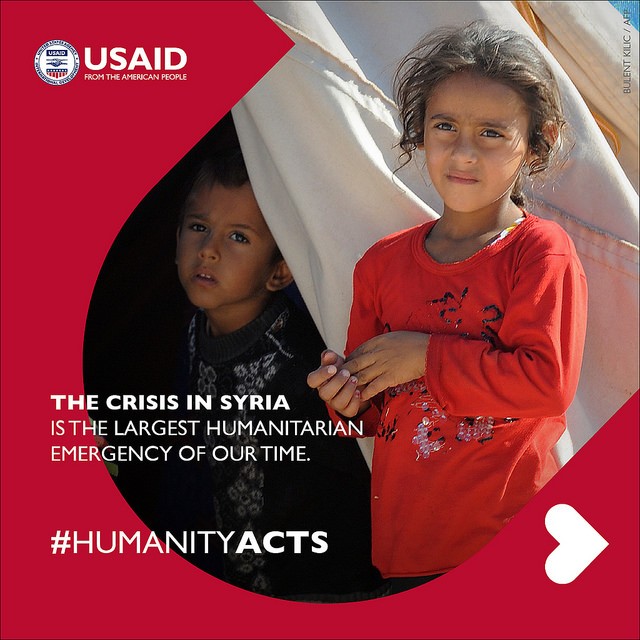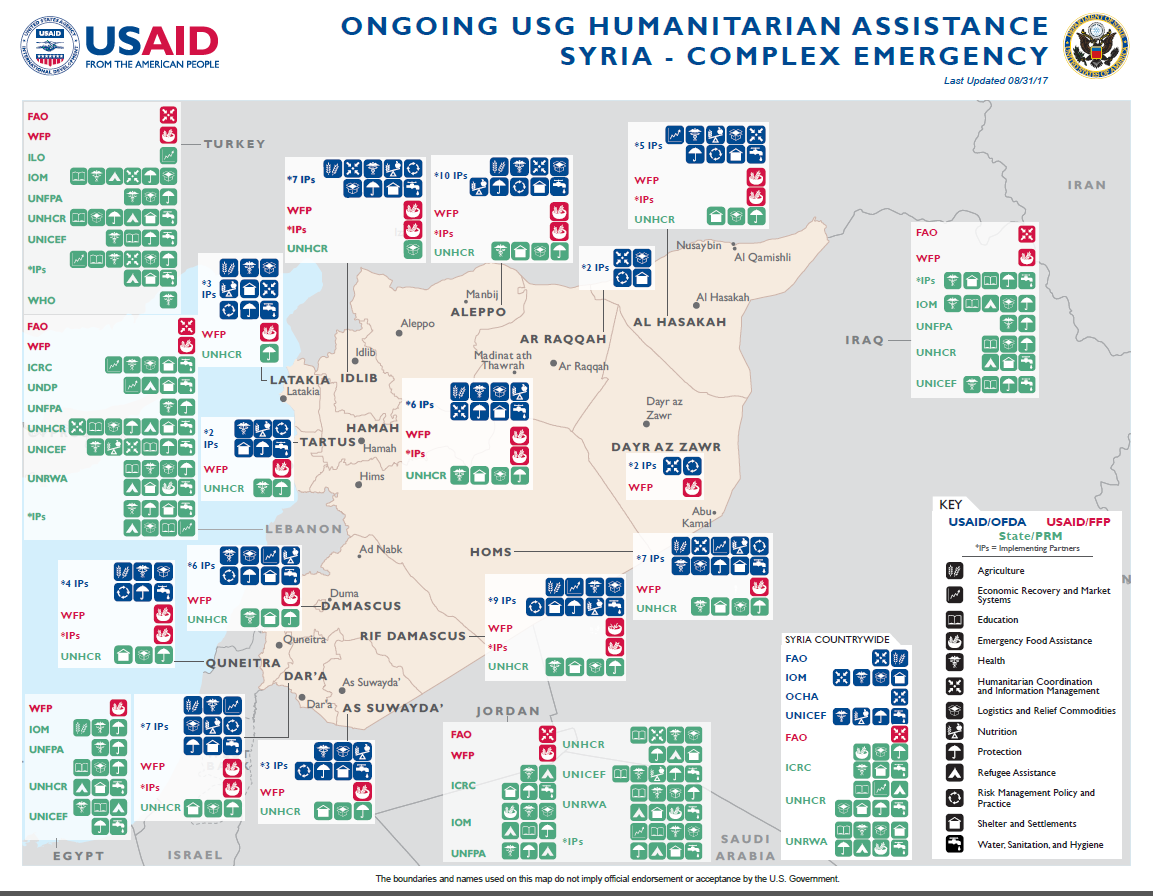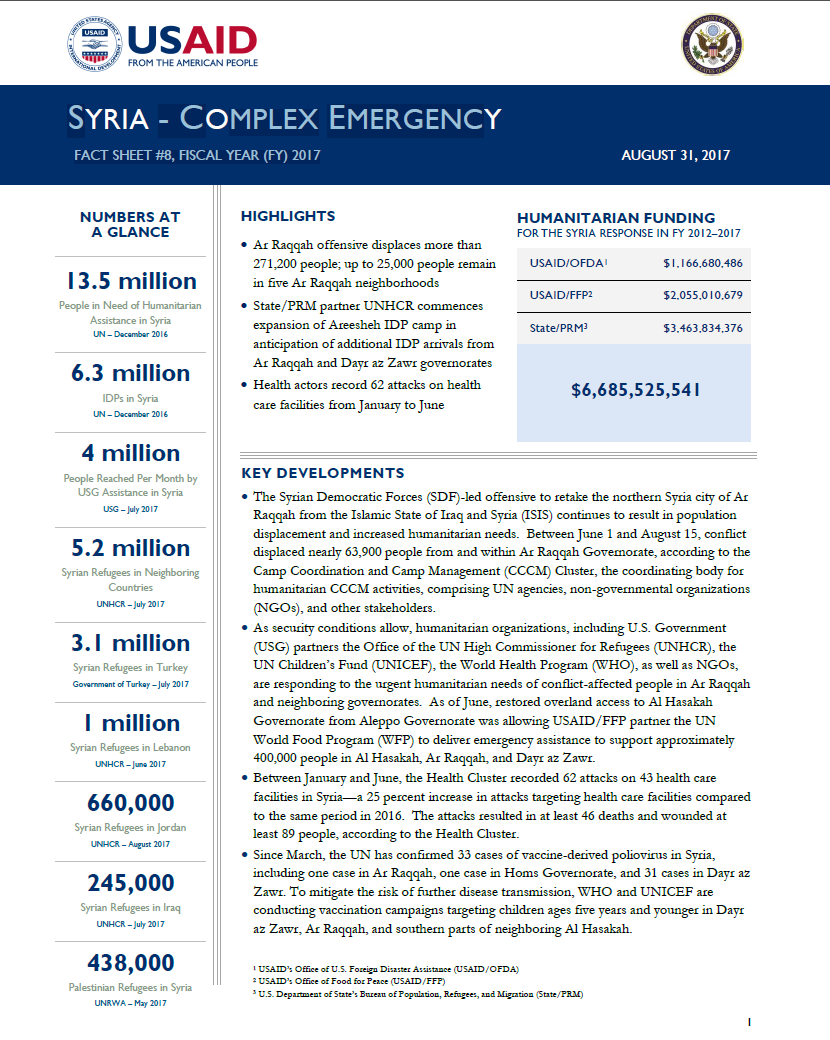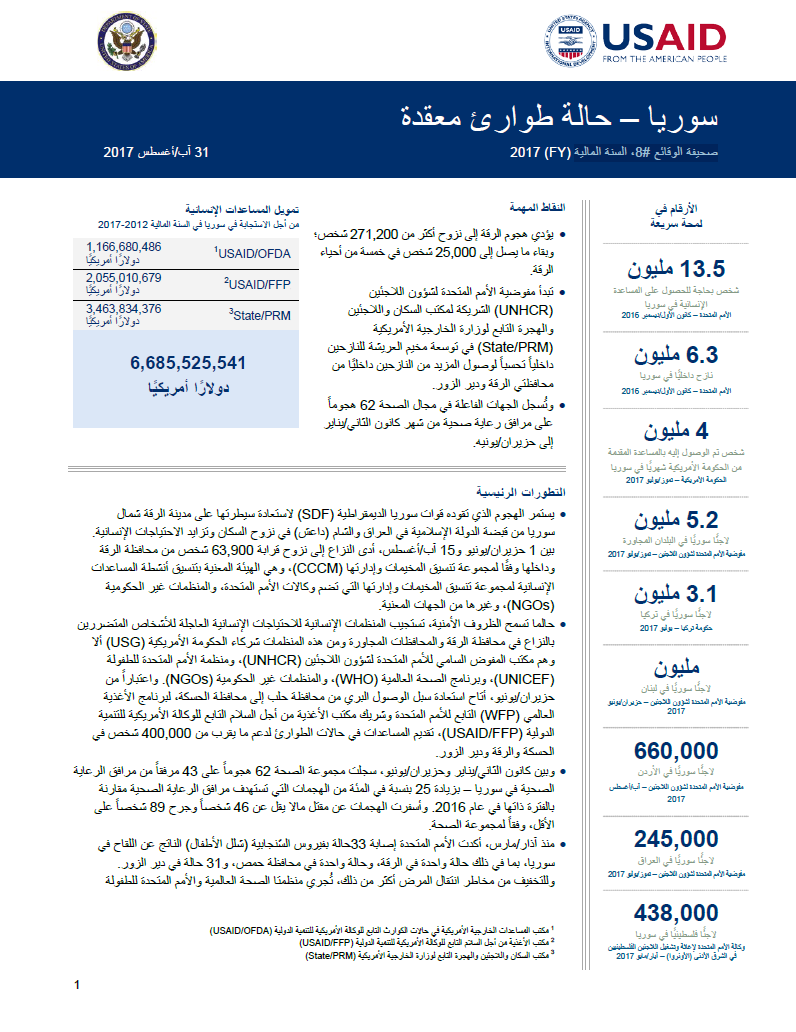- What We Do
- Agriculture and Food Security
- Democracy, Human Rights and Governance
- Economic Growth and Trade
- Education
- Ending Extreme Poverty
- Environment and Global Climate Change
- Gender Equality and Women's Empowerment
- Global Health
- Water and Sanitation
- Working in Crises and Conflict
- Disaster Assistance
- Political Transition Initiatives
- Conflict Mitigation and Prevention
- Countering Violent Extremism
- Disaster Risk Reduction
- Peacebuilding and Reconciliation
- Providing Safe & Secure Environments for Development
- Recovering From Crisis
- Resilience
- Tech Challenge for Atrocity Prevention
- World Humanitarian Day
- U.S. Global Development Lab
August 31, 2017
Highlights
Ar Raqqah offensive displaces more than 271,200 people; up to 25,000 people remain in five Ar Raqqah neighborhoods
State/PRM partner UNHCR commences expansion of Areesheh IDP camp in anticipation of additional IDP arrivals from Ar Raqqah and Dayr az Zawr governorates
Health actors record 62 attacks on health care facilities from January to June
Key Developments
The Syrian Democratic Forces (SDF)-led offensive to retake the northern Syria city of Ar Raqqah from the Islamic State of Iraq and Syria (ISIS) continues to result in population displacement and increased humanitarian needs. Between June 1 and August 15, conflict displaced nearly 63,900 people from and within Ar Raqqah Governorate, according to the Camp Coordination and Camp Management (CCCM) Cluster, the coordinating body for humanitarian CCCM activities, comprising UN agencies, non-governmental organizations (NGOs), and other stakeholders.
As security conditions allow, humanitarian organizations, including U.S. Government (USG) partners the Office of the UN High Commissioner for Refugees (UNHCR), the UN Children’s Fund (UNICEF), the World Health Program (WHO), as well as NGOs, are responding to the urgent humanitarian needs of conflict-affected people in Ar Raqqah and neighboring governorates. As of June, restored overland access to Al Hasakah Governorate from Aleppo Governorate was allowing USAID/FFP partner the UN World Food Program (WFP) to deliver emergency assistance to support approximately 400,000 people in Al Hasakah, Ar Raqqah, and Dayr az Zawr.
Between January and June, the Health Cluster recorded 62 attacks on 43 health care facilities in Syria—a 25 percent increase in attacks targeting health care facilities compared to the same period in 2016. The attacks resulted in at least 46 deaths and wounded at least 89 people, according to the Health Cluster.
Since March, the UN has confirmed 33 cases of vaccine-derived poliovirus in Syria, including one case in Ar Raqqah, one case in Homs Governorate, and 31 cases in Dayr az Zawr. To mitigate the risk of further disease transmission, WHO and UNICEF are conducting vaccination campaigns targeting children ages five years and younger in Dayr az Zawr, Ar Raqqah, and southern parts of neighboring Al Hasakah.
Syria - Complex Emergency Map #8, (FY) 2017 ![]() (pdf - 467k)
(pdf - 467k)
Numbers At A Glance
13.5 million
6.3 million
4 million
5.2 million
3.1 million
1 million
660,000
245,000
438,000
Humanitarian Funding
To Syria Humanitarian Response
FY 2012 - FY 2017
| USAID/OFDA | $1,166,680,486 |
| USAID/FFP | $2,055,010,679 |
| State/PRM | $3,463,834,376 |
| TOTAL | $6,685,525,541 |
Syria - Complex Emergency Fact Sheet #8, (FY) 2017 ![]() (pdf - 243k)
(pdf - 243k)
سوريا – حالة طوارئ معقدة ![]() (pdf - 221k)
(pdf - 221k)
INSECURITY AND POPULATION DISPLACEMENT
Insecurity continues to result in displacement throughout Syria and to neighboring countries, with nearly 809,000 people displaced between January and July, according to the International Organization for Migration (IOM). An estimated 6.3 million people remain internally displaced in Syria, while more than 5 million Syrian refugees remain in neighboring countries.
Between January and July, nearly 603,000 displaced Syrians returned to their areas of origin, IOM reports. IOM recorded nearly 686,000 returns in 2016, indicating an increasing trend of returns to date in 2017. Approximately 95 percent of returnees were internally displaced persons (IDPs), while IOM also recorded limited Syrians refugee returns from Turkey, Lebanon, Jordan, and Iraq. An estimated 27 percent of returnees stated that they returned home to protect their assets and properties, while 25 percent reported that improved economic conditions in areas of origin motivated their return. An estimated 67 percent of returnees—more than 405,000 people—returned to Aleppo Governorate, following the trend observed in 2016, when half of all returns were to Aleppo.
IOM reports that 83 percent of returnees have access to food and 80 percent of returnees have access to household commodities; however, only 41 percent of returnees have access to safe drinking water and 39 percent of returnees have access to health care services due to conflict-related infrastructure damage.
Northern Syria
The SDF offensive to recapture Ar Raqqah from ISIS continues to drive population displacement to SDF-held areas of Ar Raqqah and neighboring governorates. Civilians are fleeing the city despite reports of ISIS-planted landmines and sniper fire along southern escape routes and efforts by ISIS to consolidate civilians toward the city center, according to the UN Office for the Coordination of Humanitarian Affairs (OCHA). Overall, the conflict has displaced more than 271,600 people from and within Ar Raqqah since November 2016.
As of mid-August, an estimated 18,000–25,000 people remained in five of Ar Raqqah’s 24 neighborhoods, OCHA reports. Civilians remaining in Ar Raqqah face increasingly dire conditions, with limited access to food, safe drinking water, and essential services. Food markets are reportedly functional in only two of the city’s neighborhoods, with many staple food items available sporadically and at elevated prices, according to a recent humanitarian assessment. Households remaining in Ar Raqqah continue to rely on previously stored food supplies and are reducing meal sizes, skipping meals, or purchasing food on credit to cope with reduced access to food, according to the assessment.
With support from State/PRM, UNHCR is expanding Al Hasakah’s Areesheh IDP camp to accommodate additional influxes of IDPs from Ar Raqqah and Dayr az Zawr. In the coming weeks, the UN agency plans to increase the camp’s capacity from 8,700 people to 19,200 people. UNHCR estimates that the camp currently hosts approximately 7,000 IDPs; as of late August, local authorities had begun directing newly arrived IDPs—including approximately 1,700 IDPs who fled Dayr az Zawr from August 21–23—to Al Hasakah’s Mabroka IDP camp to alleviate potential congestion and camp management challenges at Areesheh until the site’s capacity is increased.
Southern and Central Syria
Pursuant to the terms of a late July ceasefire between the militant groups Hezbollah and Hayat Tahrir al-Sham (HTS), approximately 5,000 to 8,000 Syrians, including HTS fighters, their families, and other refugees, relocated from Lebanon’s Arsal District to Syria’s Idlib Governorate on August 2, according to international media and relief agencies. The relocation represents the largest single repatriation of refugees to Syria since the conflict began in 2011. The UN was not involved in the relocation; however, relief agencies are coordinating response efforts to respond to needs of returning populations.
Following the July takeover of Idlib by HTS, humanitarian organizations have expressed concern regarding additional access constraints within the governorate. As of mid-August, at least one NGO had temporarily suspended shipments of relief commodities from Turkey through Idlib’s Bab al-Hawa border crossing, international media report.
HUMANITARIAN ACCESS
Humanitarian organizations report continued high levels of need in HTS-controlled areas, including in Idlib, where an estimated 465,000 people require emergency food assistance and an additional 253,000 people are at risk of food insecurity, according to the UN. USAID/FFP-funded food assistance is supporting an estimated 769,200 people in HTS-dominant areas. In addition, USAID/OFDA partners are providing vulnerable populations in HTS-held areas with life-saving assistance, including support for agriculture and livelihoods, emergency relief commodities, logistics, nutrition, protection, shelter, and water, sanitation, and hygiene (WASH).
As of June 30, an estimated 4.5 million people in need of humanitarian assistance were living in Syria’s UN-identified hard-to-reach (HTR) locations. The figure includes approximately 540,000 people residing in 30 besieged locations, 27 of which are besieged by the Syrian Arab Republic Government (SARG). Since April, the population in need of assistance in non-besieged HTR areas increased by nearly 97,800 people, while the population requiring assistance in besieged locations decreased by approximately 84,500 people. The reduction corresponds to the UN’s removal of the besieged classification from two locations—the Al Wa’er neighborhood in the city of Homs and the area encompassing the towns of Madaya and Bqine in Rif Damascus Governorate—following local agreements that ended SARG sieges in those areas.
Between January 1 and August 16, UN agencies and partners delivered multi-sector assistance through interagency operations to nearly 733,500 people in besieged and HTR areas of Syria. A total of 31 interagency convoys delivered humanitarian assistance to numerous locations in Syria, while more than 130 WFP-led airdrops transported more than 2,700 MT of emergency food assistance to besieged locations in the city of Dayr Az Zawr. Since April 2016, WFP has completed 300 high-altitude airdrops to Dayr Az Zawr.
AGRICULTURE AND FOOD SECURITY
Food security conditions in the SARG-besieged Eastern Ghouta region of Rif Damascus improved in July, WFP reports. According to the UN agency’s latest vulnerability assessment, seasonal factors and the May 4 agreement to establish de-escalation zones have improved Eastern Ghouta households’ access to more diverse, nutritious, and quality food items; however, despite recent improvements, food remains a priority humanitarian need in the region.
Meanwhile, access to food remains limited in the city of Ar Raqqah and rural areas of Dayr az Zawr, with residents continuing to rely on existing food stocks. According to WFP, the proportion of households in Ar Raqqah and Dayr az Zawr governorates reporting emergency food assistance as their primary food source increased from 11 percent in May to 16 percent in July. Additionally, the proportion of households indicating food purchases as their primary food source fell from 77 percent in May to 71 percent in July, WFP reports.
In July, WFP continued to support 11 bakeries in Aleppo, including three located in formerly inaccessible areas, to provide bread for approximately 515,000 people in the city and nearby rural areas. Additionally, WFP is supporting approximately 290,000 people who have returned to formerly inaccessible areas of Aleppo with monthly food rations.
In August, USAID/FFP partner WFP provided emergency food assistance to nearly 4.2 million people in Syria, including through cross-border operations from Jordan and Turkey, cross-line interagency convoys, and airdrops to besieged areas. On August 19, WFP provided emergency food assistance to 84,000 people and nutrition supplies to 800 children in the HTR area of Talbiseh, located in northern rural Homs, marking the first time that the UN agency was able to access the area since June.
HEALTH AND WASH
From January to June, the Health Cluster recorded 62 attacks on 43 health facilities in Syria, resulting in at least 46 deaths, including 18 health workers and 11 patients, and wounding at least 89 people. These incidents represent a 25 percent increase in recorded attacks against health care facilities compared to the same time period in 2016.
From August 7–15, WHO reported three new laboratory-confirmed cases of vaccine-derived poliovirus in Syria. The cases include two cases from Dayr az Zawr, originating from Abu Kamal and Dayr az Zawr districts, and one case originating from Homs’s Tadmor District. The three occurrences of polio represent the first cases confirmed in each area. Cumulatively, the UN has reported 33 laboratory-confirmed cases in Syria; the previous 30 cases included 29 from Dayr az Zawr’s Al Mayadin sub-district and one from Ar Raqqah’s Tel Abyad District. As of August 22, an additional 11 suspected cases, including 10 from Dayr az Zawr and one from Ar Raqqah, were pending laboratory testing.
From late July to mid-August, USG partners WHO and UNICEF conducted the first round of polio vaccination campaigns in Ar Raqqah, Dayr az Zawr, and southern locations of Al Hasakah’s Shadadi District. Teams vaccinated approximately 355,000 children ages five years and younger, reaching approximately 88 percent and 86 percent of the target population in Dayr az Zawr and Ar Raqqah, respectively.
In mid-August, in response to confirmed poliovirus cases in Syria, the Lebanese Ministry of Public Health (MoPH) announced the acceleration of Inactivated Polio Vaccine (IPV) provision to all children ages five years and younger in Lebanon. With support from State/PRM, the UN plans to procure 144,000 doses of IPV for use in Lebanon. Health agencies, in cooperation with the MoPH, plan to distribute the IPV to more than 200 primary health care centers, border points, and UNHCR registration centers in Lebanon. The MoPH plan aims to provide all children ages five years and younger in Lebanon, including more than 160,000 registered Syrian refugee children, with free immunizations.
With USAID/OFDA support, an NGO conducted sessions on hygiene promotion, waterborne-disease prevention, and sunstroke prevention for vulnerable populations in northwestern Syria, including at IDP camps in Idlib, from July 17–31. These sessions reached more than 2,500 people, including more than 770 children. The USAID/OFDA partner also continued efforts to rehabilitate WASH systems in northwestern Syria. As of July 31, the organization had rehabilitated seven of eight targeted water supply systems in Aleppo and Idlib.
CONTEXT
Following the commencement of peaceful demonstrations against the SARG in March 2011, President Bashar al-Asad pledged legislative reforms. However, reforms failed to materialize, and SARG forces loyal to President al-Asad began responding to demonstrations with violence, leading armed oppositions groups to retaliate.
At a November 2012 meeting in Doha, Qatar, Syrian opposition factions formed an umbrella organization—the National Coalition for Syrian Revolutionary and Opposition Forces, also known as the Syrian Coalition. The USG recognized the coalition as the legitimate representative of the Syrian people on December 11, 2012. On March 19, 2013, the Syrian Coalition established the Syrian Interim Government, which opposes the SARG and is based in decentralized locations throughout opposition-held areas of Syria.
On July 14, 2014, the UN Security Council (UNSC) adopted UN Security Council Resolution (UNSCR) 2165, authorizing UN cross-border and cross-line delivery of humanitarian aid to conflict-affected populations without SARG approval. The resolution permits the UN’s use of four border crossings from Turkey, Jordan, and Iraq—in addition to other crossings already in use by UN agencies—for delivery of humanitarian assistance into Syria. The resolution also establishes a monitoring mechanism under the authority of the UN Secretary-General and with the consent of neighboring countries to ensure that deliveries across these border points contain only humanitarian items. The UNSC has subsequently adopted several resolutions renewing the mandate of UNSCR 2165, most recently in December 2016 with the adoption of UNSCR 2332, extending the authorities granted until January 2018.
Prior to the start of the conflict, UN Relief and Works Agency for Palestine Refugees in the Near East (UNRWA) had registered approximately 560,000 Palestinian refugees in Syria, with more than 80 percent living in and around Damascus. Intense fighting in and around some Palestinian camps and neighborhoods has significantly affected Palestinian refugees in Syria. UNRWA estimates that approximately 60 percent of Palestinian refugees are displaced within Syria, with a further 110,000 Palestinian refugees displaced in neighboring countries. Syria also hosts an estimated 24,000 Iraqi refugees and asylum seekers, primarily in the greater Damascus area, as well as more than 3,200 refugee persons of concern from other countries.
PUBLIC DONATION INFORMATION
The most effective way people can assist relief efforts is by making cash contributions to humanitarian organizations that are conducting relief operations. A list of humanitarian organizations that are accepting cash donations for disaster responses around the world can be found at www.usaid.gov/crisis/syria.
The USG encourages cash donations because they allow aid professionals to procure the exact items needed (often in the affected region); reduce the burden on scarce resources (such as transportation routes, staff time, and warehouse space); can be transferred very quickly and without transportation costs; support the economy of the disaster-stricken region; and ensure culturally, dietary, and environmentally appropriate assistance.











Comment
Make a general inquiry or suggest an improvement.